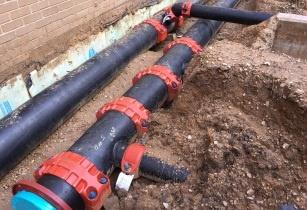By Barry van Jaarsveld, Victaulic Regional Manager for Africa
The South African Property Owners Association (SAPOA) paints a rather bleak picture of the current South African commercial building sector in a recent quarterly report, stating that the national office vacancy rate is currently at its highest in 12 years. This is not surprising, given the fact that business capital investment in our country remains negative at -1.6 per cent, which often prompts a selective approach to capital allocation. The SAPOA report also indicates that office vacancy rates could deteriorate further before improving.
However, leasing opportunities still do exist, with 23 of the country’s 53 office nodes reporting improved occupancy rates during the first quarter. In these nodes, quick, reliable solutions focused on reducing building maintenance costs and the need for skilled labour are crucial. In addition, for new commercial developments, innovative technologies that decrease construction times, limit labour costs, and prove more versatile will be particularly lucrative.
One such technology provides a groundbreaking solution to constructing and maintaining the piping systems for heating, cooling, plumbing and fire protection in commercial buildings. Traditionally, flanges and welding have been used for this purpose. However, mechanical pipe joining systems are a far more cost-effective, time-saving and reliable alternative that last over the lifetime of the pipe system.
For example, using mechanical pipe joining systems can have a significant impact on construction schedules. Contractors are always under pressure to finish a project, whether it be a new building or a renovation, and unplanned stoppages can put increased pressure on schedules and budgets. A pipe joining solution such as that offered by Victaulic can relieve some of this pressure through quicker installation. The Victaulic system can also contribute to a much greener building process, as installation does not require welding and therefore uses less energy.
Victaulic’s mechanical pipe joining system requires fewer and less skilled workers, which further reduces installation costs. In addition, with no fire risk, there is no need for fire protection and the health and safety risks on the job site are limited. There are also fewer people working on site for a shorter period of time, which in itself reduces health and safety risks.
Pipe joining technology is especially suited to commercial building projects as it can easily accommodate changes in the scope of the project. Unlike a welded system, a mechanical pipe joining system can easily be taken apart and the same parts can be reassembled. The initial installation of the Victaulic system is about five times faster than welding, but when welded systems need to be reworked, the Victaulic system can be ten times faster.
The reduction in safety concerns also simplifies maintenance or additions and renovation to existing buildings. As there is no fire risk, the Victaulic system can safely be installed while tenants are in the building. Victaulic makes use of a union at every joint, providing easy access for maintenance and system expansions.
Yet there is still a widely held perception that pipe coupling technology can only be used on a temporary basis. It must be stressed that this is not the case. Victaulic offers a permanent solution that lasts the lifetime of the pipe system. Our pipe joining technology has been used in buildings like the CN Tower in Canada, the Petronas Towers in Malaysia and Trump Tower in the United States. South African installations include the Telkom Data Centre in Centurion as well as the Standard Bank Building in Rosebank.
The Standard Bank Head Office, which was built to reflect sustainability, is a particularly compelling case study of how pipe joining is a far more efficient and effective way of installing an HVAC system. The developers faced numerous challenges when it came to the construction of the building. Space constraints made it impossible for flanges and traditional expansion and contraction methods to be installed, while welding would have meant longer lead times and safety risks due to open flames and noxious emissions.
Victaulic QuickVic® Installation-Ready couplings and grooved fittings overcame these challenges and ensured a fast, safe and efficient installation of the riser pipelines. Tight installation spaces were easily completed due to the push-on nature of Quick-Vic couplings. There were no loose bolts, nuts or gaskets that could be dropped within the vertical riser space, which resulted in improved efficiency and minimised time wasted. Additionally, the fact that the joint installation needed only a quick visual verification to confirm its validity eliminated additional checks and rework. Originally estimated to require two full weeks to complete the system by welding, Victaulic QuickVic couplings helped to compress the assembly to 19 hours – nearly 75 per cent savings in installation time – and 1 and a half weeks ahead of schedule.




